A sprint retrospective can be the most powerful meeting of an agile team. If facilitated well, it allows the team to improve its effectiveness, resolve conflicts before they happen, and help everyone excel.
However, facilitating a retrospective session is often harder than it seems. Many people fall into the same repetitive structure:
- Ask people to write sticky notes for things that were well and bad
- Discuss or vote for sticky notes
- Choose 2–3 action points
While there’s nothing wrong with the approach itself, the problem appears when this format is repeated over and over again. People quickly get used to it and get bored, and the meeting no longer forces the team to think deeply about improving its processes.
Try to mix up retrospectives. It might seem difficult to come up with new ideas every time, but in reality, it just takes 10–20 minutes of prep to come up with an exciting retro format — an investment that pays off.
Table of contents
Setting the stage
A retro usually needs a warm-up. It puts everyone in the right mood and might bring additional insights that’ll impact the retrospective direction.
Some warm-up exercises include:
1. Check-in
Purpose
- Help people put aside other concerns and focus on the retrospective
- Help people articulate what they want from the retrospective
Description
After welcoming the participants, ask them one brief question. Each person answers in a round-robin fashion.
Examples of questions include:
- What is one word that describes what you need for yourself from this session?
- In a word or two, what are your hopes for the retrospective?
2. Temperature reading
Purpose
Quickly understand the mood of retrospective participants and possibly get additional insights from that.
Description
Sketch a thermometer and ask everyone to put a dot vote on a temperature that reflects their mood. Possibly, ask them to write down why they voted that way.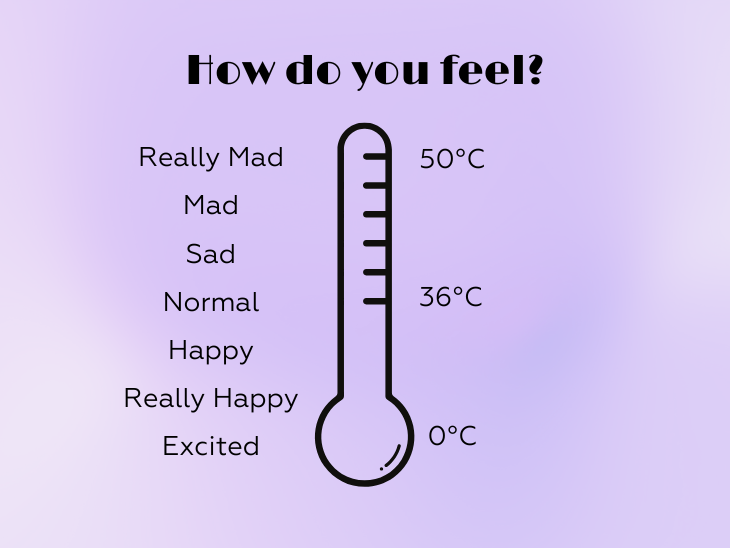
3. Amazon review
Purpose
To quickly gather qualitative and quantitative data on how the sprint went according to the team.
Description
Ask everyone to write a short review of the sprint, including:
- Title
- Description
- Star rating (1–5)
Then, let everyone read others’ reviews. It can be done publicly or anonymously.
4. One word
Purpose
Get a quick overview of how the team perceives the last iteration.
Description
Ask everyone to describe the sprint in one word only. You can extend the exercise by further asking team members why they chose given words.
5. Impromptu networking
Purpose
Energize everyone and help participants break the ice.
Description
Select a topic, and give people 1-2 minutes to discuss the issue in pairs. You can run a few iterations. This works great if the participants don’t know each other well. People can talk about how the sprint went well, about expectations toward the meeting, or even basic things like their favorite hobbies.
Gathering data
To truly improve, you need first to gather data. In some cases, you bring data to the meeting. In other cases, you need to gather it during the retrospective itself.
XXX
6. Timeline
Purpose
Understand how specific events and situations impacted the whole sprint and the team’s morale.
Description
Create a timeline from the start of the sprint until its completion. Then, write down all relevant events (big meetings, extraordinary events, critical bugs, etc.). After, write down sticky notes with positive and negative things that happened in the sprint and put them on the timeline accordingly.
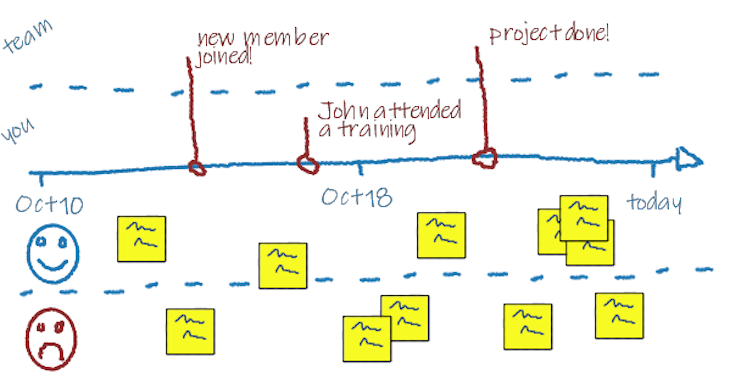
7. Team radar
Purpose
Evaluate how well the team lives by its values.
Description
Create a radar chart with all team principles/rules listed. Either ask everyone to draw a radar chart on top of it or use a voting system to define the score for each value. As a result, you will get a bird’s eye view of how the team delivers in terms of agreed values and principles.
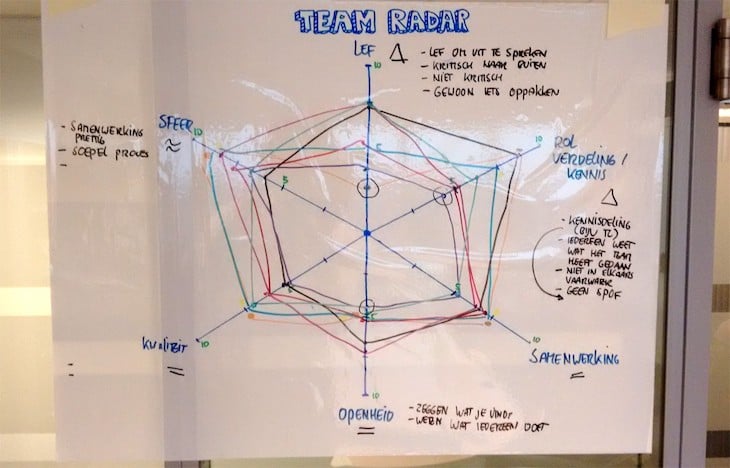
8. Sailboat
Purpose
Define obstacles and opportunities on the team’s way to achieving the goal.
Description
Sketch a sailboat. Create room for four types of quadrants:
- Propellers — What moves you forward as a team?
- Life preservers — What can save you in case of problems?
- Anchors — What slows you down?
- Rocks — What are the core risks for the initiative?
Answer the questions and add sticky notes.
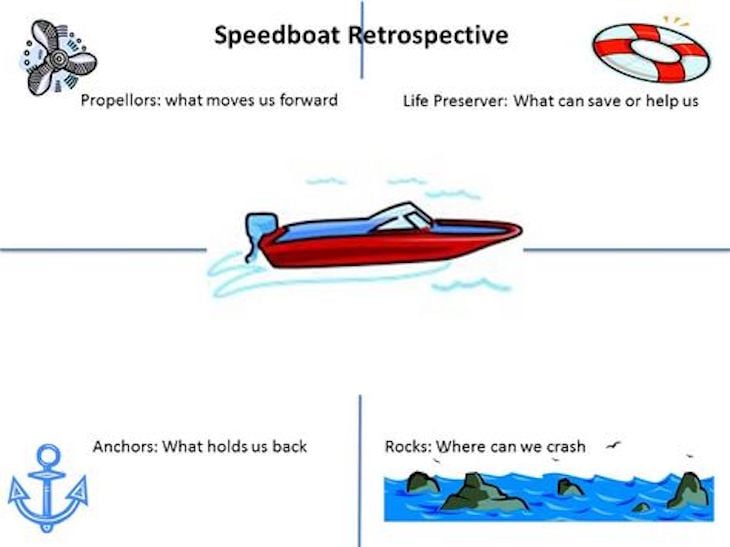
9. Mad Sad Glad
Purpose
Define events and situations that evoked specific emotions.
Description
Create three columns. Ask the team to write down things that made them mad, sad, and glad. You want to make sure you emphasize what or why people have those emotions. There’s also a simpler variation with two columns: what made you proud during the last sprint? What made you feel sorry?
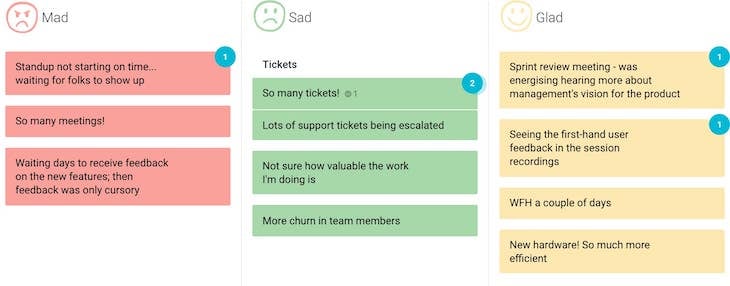
Generating insights
When you have relevant data gathered, you need to generate insights on how to move forward and tackle challenges.
10. 1-2-4-all
Purpose
Equally engage everyone in seeking solutions.
Description
- Present the team with a challenge
- Let everyone think of a solution alone
- Ask the team to form pairs to discuss and build on top of their solutions
- Ask pairs to form groups of four to discuss further and build on top of their solutions
- Present all solutions to the group
For smaller groups, you might try a 1-2-all variation:
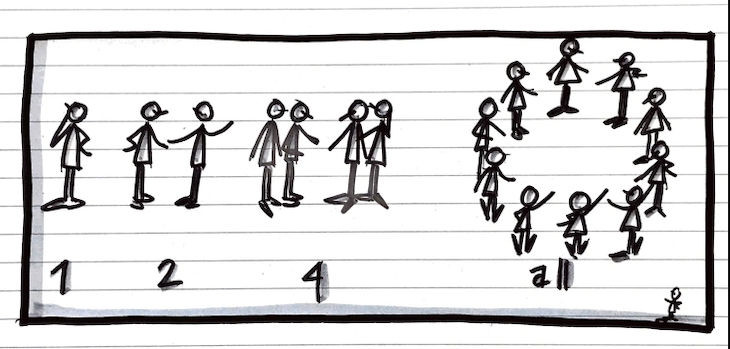
11. Alternating brainstorming
Purpose
Combine the benefits of group brainstorming and focused solo work.
Description
Brainstorming solo tends to generate more insights, but group brainstorming allows people to inspire each other which boosts creativity. Alternate between the two to maximize benefits.
- Present the team with a challenge
- Let everyone think about solutions alone (solo brainstorming)
- Have everyone say their solutions to the whole group (group brainstorming) to spark creativity and share inspirations
- Let people go back to solo brainstorming
- Repeat if needed
12. Triple nickels
Purpose
To help the team expand others’ ideas.
Description
Each person has five minutes to brainstorm and write down ideas individually. At the end of five minutes, each person passes the paper to the person on their right. That person has five minutes to write down ideas that build on the ideas already written on the paper. Repeat until the paper returns to the original writer.
Deciding what to do
A great retro ends up with clear next steps. Make sure you have at least one. If you have numerous ideas and insights on processing, try to group the first using affinity mapping.
13. Dot voting
Purpose
Quickly prioritize ideas by voting.
Description
List down all ideas for solving the problem. Then, each participant votes on the ideas they like the most. There are numerous variations of this exercise:
- It can be anonymous or public
- People might be able to add many votes to the same idea or a maximum of one
- The number of votes might be limited or unlimited
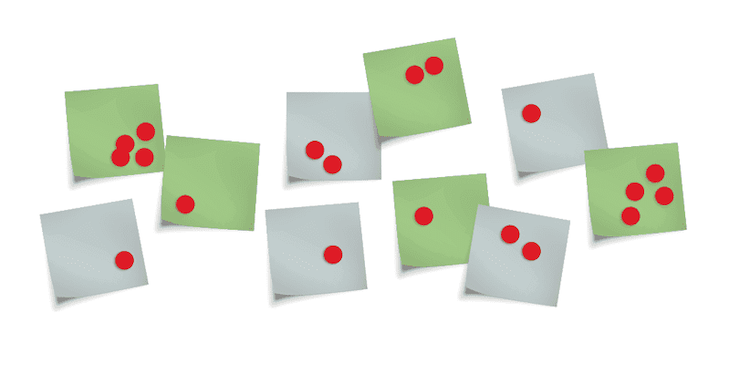
14. Effort and impact scaling
Purpose
Find low-hanging fruits and big bets worth taking.
Description
Rate all ideas in terms of the impact you expect them to have and the effort to implement them. Ideas with high impact and low effort are low-hanging fruits that should be prioritized. Big bets with high effort but high impacts are also worth considering.
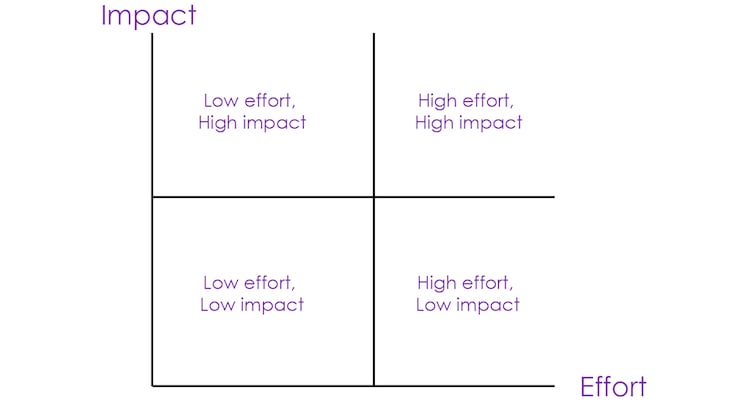
15. Criteria scoring
Purpose
Prioritize solutions based on a defined list of criteria.
Description
Decide what criteria you want to consider when making a decision. Then, score each idea 1-5 based on the criteria. Sum up the scores and prioritize ideas with the highest number.
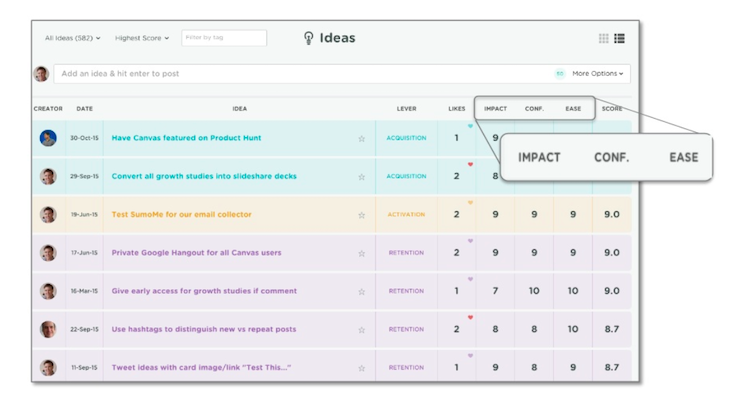
16. Circle of questions
Purpose
To choose the next action steps by asking questions inside the team.
Description
Have the team sit in a circle (or choose a specific order if the session is remote). Turn to the person on your right, and ask the question: “From your perspective, what is the highest priority for us to try in the next iteration?” The person should answer the question and then turn to their right and either ask a question that extends the discussion or starts a new one. Keep the circle going until you are satisfied or run out of time.
Closing retrospective
Spend the last few minutes of the meeting to close the retrospective properly. It’s harder to remember the meeting if it ended abruptly without closure.
17. Appreciations
Purpose
Improve team relationships by sharing appreciation.
Description
Ask participants to share what they appreciate about the team or someone specific. This exercise works especially well if the retrospective is tough and conflict-ridden. Plus, these types of conversations boosts morale significantly.
18. Temperature reading
Purpose
Quickly understand the mood of retrospective participants and compare it to their mood at check-in.
Description
The rules are the same as in the case of the check-in exercise. Sketch a thermometer and ask everyone to put a dot vote on a temperature that reflects their mood. Possibly ask them to write down why they voted that way. This allows you to compare the changes and evaluate the effectiveness of the meeting itself.
19. What, so what, now what?
Purpose
To recap the most important outcomes of the retrospective.
Description
Either as a group or using 1-2(-4)-all variation, discuss and write down an answer for three sets of questions:
- What happened? What did you notice? What facts or observations stood out?
- Why is that important? What patterns or conclusions are emerging? What hypotheses can I/we make?
- Now what? What actions make the most sense?
20. Retro’s bullseye
Purpose
To evaluate the meeting in the most important areas.
Description
Decide on a set of criteria to evaluate your retrospectives. Then, prepare a dart target for each of the criteria. Ask participants to vote on how well the meeting went according to the criteria. The closer to the bullseye, the better the meeting was. It can be public or anonymous. You can also have a follow-up discussion if needed. This exercise works best if repeated regularly to compare if the meeting improves over time.
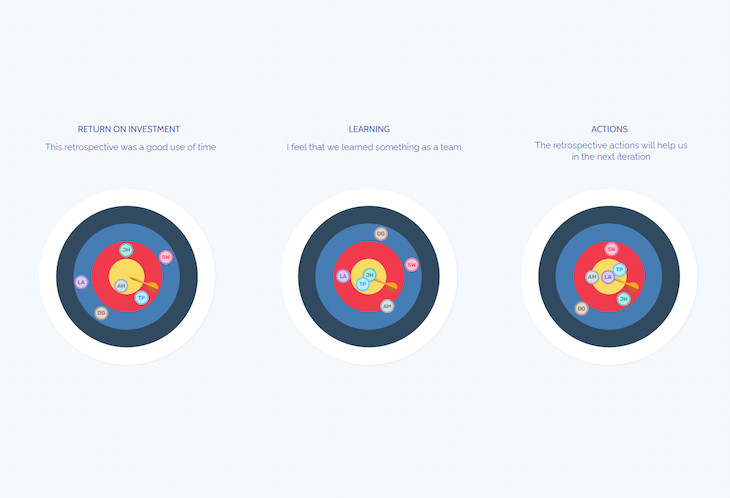
Featured image source: IconScout
The post How to run more effective sprint retros: 20 fresh formats and ideas appeared first on LogRocket Blog.
from LogRocket Blog https://ift.tt/mnD2kSP
Gain $200 in a week
via Read more



